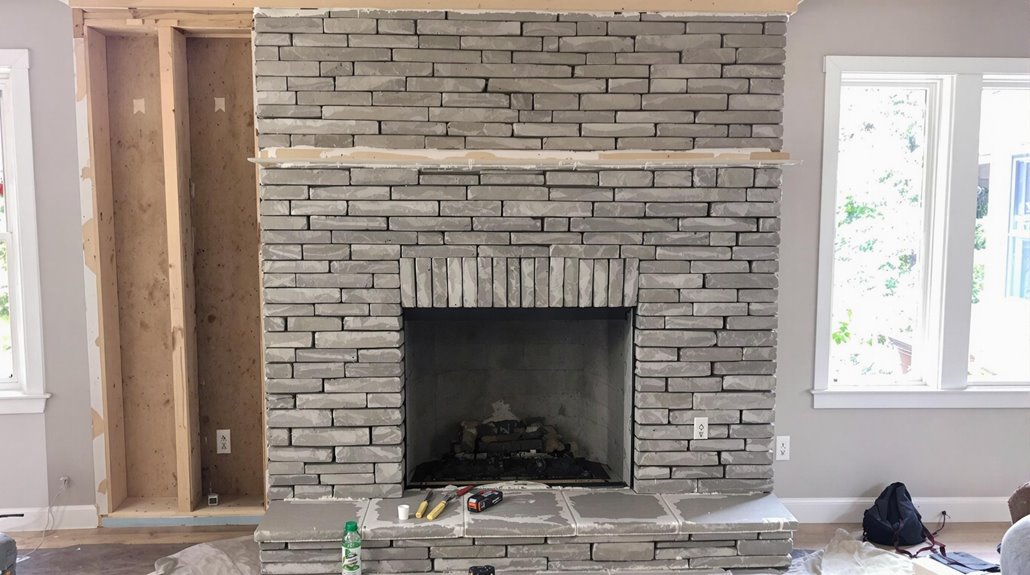When I installed my first built-in fireplace last winter, I transformed a basic living room into a cozy retreat that added $15,000 to my home’s value. I’ll share the exact steps I took to select, plan, and construct a DIY fireplace that meets all safety codes while saving thousands in contractor fees. Whether you’re considering a traditional wood-burning hearth or a modern gas insert, there’s a perfect fireplace solution waiting in these proven techniques.
Types of Built-In Fireplaces: Choosing the Right Option

When you’re planning to install a built-in fireplace, you’ll need to navigate through several distinct options that can dramatically transform your living space.
I recommend starting with traditional fireplaces, which use wood or gas and create that classic, cozy ambiance we all love. These models require proper ventilation and a chimney system.
For a more contemporary approach, I suggest exploring modern designs that include electric and ethanol-powered options.
I’ve found that these sleek alternatives often feature customizable flame effects, require minimal maintenance, and don’t need extensive ventilation systems.
Today’s built-in electric fireplaces can even double as entertainment centers, while ethanol models offer clean-burning flames without the need for a gas line or electrical connection.
Safety features are paramount, so I always guarantee proper clearances and fire-resistant materials surround any installation.
Planning and Safety Considerations
Before starting any built-in fireplace project, creating a detailed safety plan will protect your home and loved ones from potential hazards.
I always recommend starting with a thorough inspection of your space, checking for proper ventilation, electrical wiring, and structural support.
When I plan built-in fireplaces, I focus on key design considerations like clearance requirements, heat-resistant materials, and proper airflow.
You’ll need to guarantee your walls can handle the weight and heat, and I suggest installing carbon monoxide detectors nearby.
Fire safety measures should include installing a proper chimney liner, maintaining adequate distance from combustible materials, and following local building codes.
I’ve learned that proper planning prevents most safety issues, so take time to research regulations, consult professionals when needed, and document every step of your installation process.
Essential Tools and Materials
A successful DIY fireplace project requires specific tools and materials to guarantee proper construction and lasting performance.
I’ll help you with tool selection by recommending essential items: a circular saw, drill with masonry bits, level, measuring tape, and safety equipment like goggles and gloves.
When it comes to material sourcing, I’ve found that quality matters most – you’ll need fire-rated bricks, mortar, cement board, metal framing, and a UL-listed fireplace insert.
You’ll also want to gather finishing materials like tiles, stone veneer, or brick facing for the surround.
I recommend sourcing these from reputable building supply stores where staff can advise on fire ratings and proper applications.
Don’t forget ventilation components, including metal flue pipes and chimney caps.
Preparing Your Space for Installation

Since proper preparation prevents problems down the line, I’ll guide you through getting your space ready for a built-in fireplace installation.
When it comes to design aesthetics and safety, careful planning is crucial before making any structural changes to your home.
- Start with accurate space measurement by measuring the room’s dimensions, including ceiling height, wall width, and depth requirements for your chosen fireplace model.
- Clear the installation area completely, removing furniture, artwork, and any wall-mounted items within a 6-foot radius of where your fireplace will go.
- Examine your flooring to confirm it can support the fireplace’s weight, and if you’re installing on an upper floor, I strongly recommend having a structural engineer verify load-bearing capacity.
Building the Framework and Support Structure
Getting your space properly measured and prepared sets the stage for the most significant structural work – building a solid framework that’ll safely support your new fireplace.
I recommend starting with high-quality framework materials, including pressure-treated lumber for the base and fire-rated steel studs for the vertical support structure.
You’ll want to guarantee each component is level, plumb, and securely fastened to both the floor and adjacent walls. I always double-check my measurements and use a laser level to maintain perfect alignment throughout the build.
When I’m constructing the support structure, I pay special attention to weight distribution and load-bearing points.
I’ll show you how to create proper bracing between studs, install blocking where needed, and reinforce corners for maximum stability.
Ventilation and Chimney Requirements
Before moving forward with your fireplace installation, proper ventilation and chimney setup must be meticulously planned to guarantee safety, efficiency, and compliance with local building codes.
I’ll help you understand the key requirements for ventilation systems and chimney types that you’ll need to take into account.
- Make certain your chimney extends at least 3 feet above the roof’s highest point where it passes through, and 2 feet higher than any structure within a 10-foot radius.
- Choose between Class A (all-fuel) or Class B (gas-only) chimney types, depending on your fireplace’s fuel source – I always recommend Class A for maximum safety.
- Install proper ventilation systems including an outside air kit, which prevents your fireplace from drawing heated air from your living space and promotes ideal combustion.
Step-by-Step Installation Guide

Installing a built-in fireplace requires six essential steps that I’ll walk you through with clear, detailed instructions to guarantee a successful and safe project.
First, I’ll help you select the perfect location, considering structural support and design aesthetics.
Next, we’ll frame the opening, making certain proper dimensions for your chosen model and fuel options.
Third, I’ll guide you through installing the fireplace unit and connecting utilities.
Fourth, we’ll focus on proper insulation and heat shielding.
Fifth, I’ll show you how to install the surround, mantel, and finishing materials.
Finally, we’ll complete safety testing and secure necessary inspections.
Throughout this process, I’ll remind you of critical measurements, clearances, and local building codes to make sure your fireplace is both beautiful and safe.
Finishing Touches and Surround Design
Once your fireplace unit is securely installed, it’s time to transform it into a stunning focal point through carefully selected finishes and design elements.
I’ll help you explore various surround materials and aesthetic styles that’ll complement your home’s decor while maintaining safety standards.
- Consider durable surround materials like natural stone, brick veneer, or ceramic tile – I always recommend non-combustible options that can withstand heat while adding texture and visual interest.
- Match your aesthetic style by selecting appropriate trim details – I’ve found that modern homes look best with clean lines and minimal ornamentation, while traditional spaces benefit from detailed moldings.
- Don’t forget practical elements like a properly sized mantel shelf, which I suggest installing at least 12 inches above the firebox for safety and functionality.
Testing and Maintenance Tips
Regular testing and proper maintenance will help guarantee your DIY built-in fireplace operates safely and efficiently for years to come.
I recommend scheduling a professional fireplace inspection at least once annually, preferably before winter, to check for any potential issues or necessary repairs.
I’ve found that creating a maintenance schedule helps me stay on top of essential tasks, including monthly checks of smoke detectors, carbon monoxide detectors, and damper operation.
Every three months, I’ll inspect the firebox for cracks, clean the glass doors, and verify the surrounding masonry remains intact.
During the off-season, I make sure to clean out all ash, seal any drafts, and inspect the chimney cap and crown for damage.
Don’t forget to test your fireplace’s ventilation system before the first use of each season.
Local Codes and Permit Requirements

Beyond the regular maintenance tasks that keep your fireplace running smoothly, you’ll need to navigate your area’s building regulations and permitting process before starting construction.
I always recommend checking local regulations early since requirements vary considerably between municipalities.
- Contact your city’s building department to obtain specific fireplace installation guidelines and schedule required inspections before, during, and after construction.
- Submit detailed permit applications including your planned dimensions, materials, ventilation specifications, and safety features like proper clearances from combustibles.
- Consider hiring a certified inspector who’s familiar with local codes to review your plans and ascertain compliance with fire safety standards.







